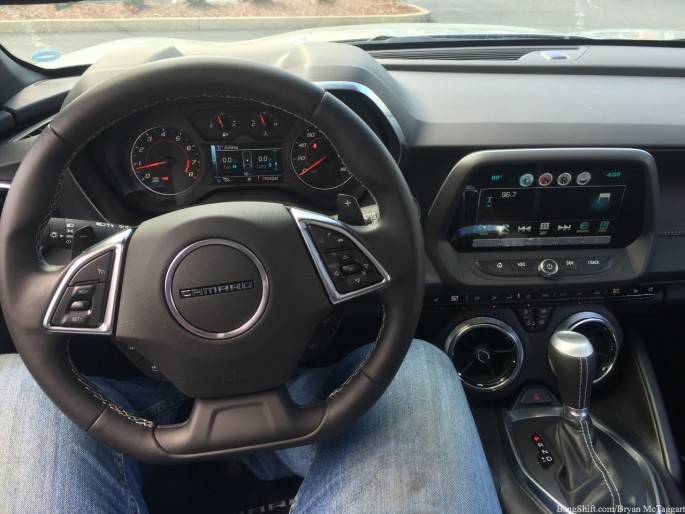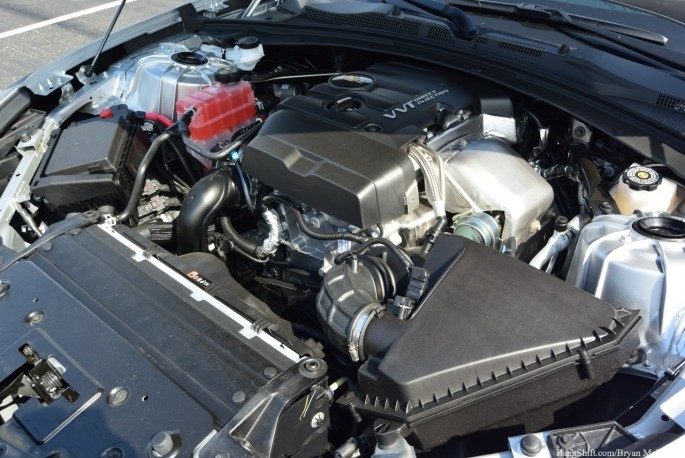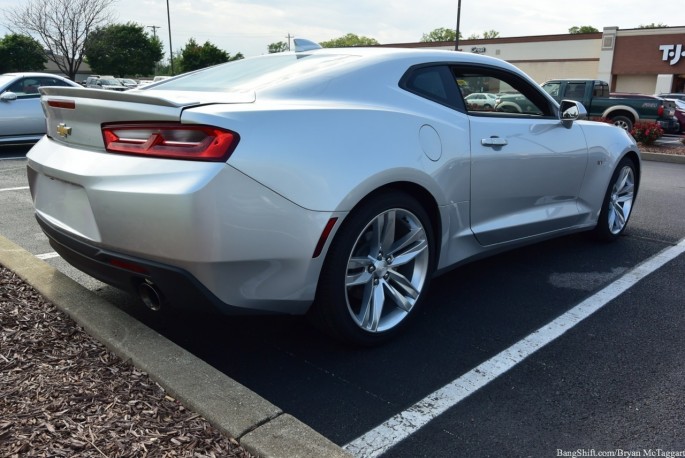In the fall of 1981, the new-for-1982 Chevrolet Camaro offered up an option that pretty much told you how bad the situation was: the LQ9, better known as Pontiac’s “Iron Duke” four-cylinder, sat as the base-model powerplant, and offered up a beyond underwhelming 90 horsepower. That put it in company with a Volkswagen Beetle and put the idea of a four-cylinder Camaro out of the heads of a lot of people for a long time. But that was thirty-four years ago, and fortunately for us, the manufacturers woke up from a haze in the 1990s, kicked off a horsepower war that has eclipsed what the 1960s brought and then some, and all of the fun that is found in the heavy hitting V8 cars has been trickling down to the standard, basic cars. It’s no longer a bad thing to pick up the smallest engine…right? Ford opened fire first, bringing out a play from the 1980s almost point-for-point: slap a turbocharger onto a 2.3L four-cylinder, stuff it into a Mustang, and let it go. In the Mustang lineup, the EcoBoost version is the mid-grade offering, while the V6 car is the low man on the pole. In Camaro hierarchy, the 2.0L turbocharged four is the base model, and it’s a winner: the LTG “Ecotec” inline four brings 275 horsepower and 295 ft/lbs of torque to the party.
We drove the V6 version of this car not too long ago, so we will skip a majority of the car review we would normally do here. The basics are pretty much the same: steering, suspension and chassis are awesome. Style is subjective, but it’s not bad. Interior layout is for the most part great, though we are not liking the gigantic iPhone-like infotainment screen in the dead center…you can only imagine how quickly that will fill up with greasy fingerprints, and it’s at just enough of an angle that at certain positions, the sun can become a problem. The trunk opening is akin to a manhole cover, but oddly enough there is a ton of room, thanks in part to being the sister car of the Cadillac ATS. Seats are good, steering wheel is the size of the one used on the Cruisin’ USA arcade game but is nice, and everything responds as well as you’d like. Now, for the strong points:

“It’s a sports car not a sedan, stop bitching about how low the roof line is..” We got that complaint about our review of the V6 Camaro. Okay, here’s our response: I’m six-foot-three, near 300 pounds. I’m a big boy. That seat is all the way back, leaned as far back as I physically can lean it. My knees are closer to the dash than I’d like, and my head, if I sit perfectly upright, is in constant contact with the roof. Nobody buys a Camaro to shuttle four people around, sure, but I stand firm: this is TOO SMALL.

That being said…I’m comfortable, the seats are pleasant places to be, and everything minus the passenger temperature control (you turn the chrome ring around the two center vents to adjust) is within reach. I fit, but barely. I’d love to sit in a Camaro without a sunroof to see the difference. Note the infotainment system. Imagine wiping that down with Windex every three days.

To General Motors: give up, get rid of the backseat, and just make it a parcel shelf. I personally know above-the-knee amputees that wouldn’t fit back here.
But the biggest question of all: how is the turbo-four to drive? Here’s your answer: a LOT better than you’d expect. It does not sound like a Honda…if anything, the noise reminds me of a SN-95 era V6 Mustang. Around town, it’s smooth, unobtrusive and torquey. It should be…the horsepower figure is on par with a 1993 Z28 Camaro, and the torque figure is pretty stout for a non-V8. Until the day we get lucky enough to track-test the cars with different engines back-to-back (NCM is right over there, gentlemen, and I can be there in minutes!) all we can say are generalities about the suspension, but it stands to reason that with less weight on the nose that the Camaro would be better balanced if you wanted to go full-on rental car fast with it. And you can get to those speeds rather quickly…clipping through the 8-speed auto in manual-matic mode, we saw 70 mph on I-65 before we saw the better part of third gear. The engine’s noise isn’t that great, but around 3500 or so RPM, you hear the turbo spool up and the engine suddenly gets a new pep in it’s step. It’s not a peaky turbo…lag isn’t an issue unless you’re trying to launch the car. And at 70 mph in eighth gear, the engine is hovering just under the 2,000 RPM mark, so with some solid highway cruising, you should see MPG figures that will make your pocketbook happy.
Is it a fire breather? No, it’s not. Is the V6 better? Yes, much better. But, is the turbo-four worth a look? Absolutely. Not everybody goes for the monster mill, and to be fair, with CAFE regulations hovering over the manufacturer’s heads, the more cars like this they sell, the better. Luckily for us, they are engineering fun into them instead of cheaping out on the bottom-end models. And that brings us to another sticking point with the Camaros we’ve tested: price. According to the Maroney sticker, base price on the 2LT is $29,800. Drop down to the 1LT level, and you’re going to be closer to $26,000. As tested, this particular car was $35,405. Why so much? Two options: the $1,950 RS package, which brings out 20″ wheels, HID headlamps with the LED trim lighting, LED taillights, rear spoiler and RS grille, and the 8-speed auto, which sets you back $1,495. Add in the $900 sunroof and a couple of minor other options (premium floor mats, the bright trim wheels, and all-season tires) and there goes your bank account. Our suggestion? Go for the 1LT package, skip the RS package, check the boxes for the heavy duty brake and cooling package (which nets you Brembo brakes, an oil cooler, and extra oil capacity) and make your call between the six-speed manual or the eight-speed auto. That will bring the Camaro closer to reality and affordability.
BangShift would like to thank J.T. and Campbell Chevrolet in Bowling Green, Kentucky for offering up this Camaro for a demo drive. Thanks, guys, you rock!















“Never in the field of human conflict has so much effort been spent on describing a heap of wheeled excrement” That famous Ford lover, Winston. Churchill on reading a review of a Chevy in 1946.
Who buys a 4 cyl Camaro. Much less a $35K 4 cyl. Camaro?
“At six foot three and nearly three hundred pounds I don’t fit”
LOL As Al Bundy once said, “I’d talk behind your back, but my car only has half a tank of gas…”
Has everybody noticed how much the Camaro looks like the ’15 Mustang in profile? If you can’t see front or rear fascia they have a striking resemblance at any distance over about 10 feet. I’m a Ford guy so it just kind of annoying ( imitation is not flattery in this case) but IF I were a bow tie guy it would really piss me off for my Camaro to look like a stripper Mustang … Just Sayin.
In 2009 I went to the dealer to buy the first V8 Camaro in the area. I left with an Impala. The roof on Camaros is too low. I’m 6’1, my head almost touched the roof, and I had to duck down a bit to see straight ahead.
I’m 6,1 180lbs and my seat back was touching the seat bottom. The interior space is actually better in a miata except for slightly more head room.
“Hey guys check out my new bitchin’ Camaro! It’s got a custom paint job, rally wheels, loaded interior, and… oh yeah…..a 4 cylinder.
Just rolls off the tongue like a turd.
Looks to me like a hairdressers car.